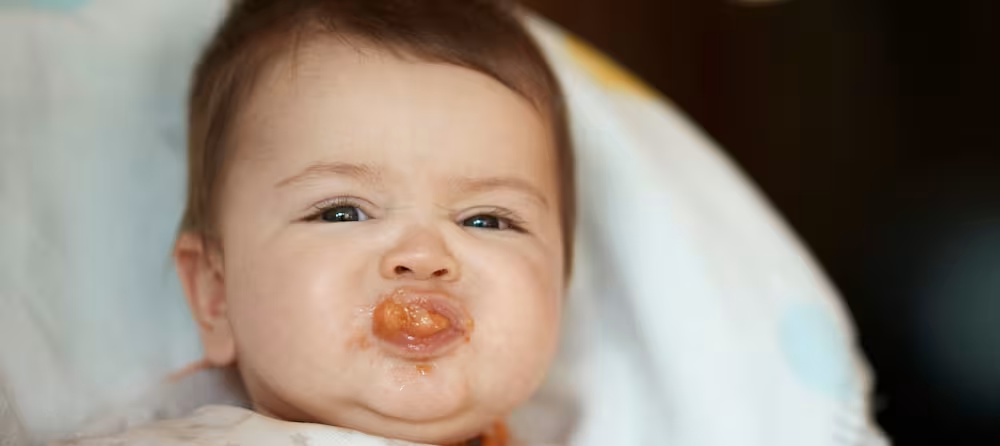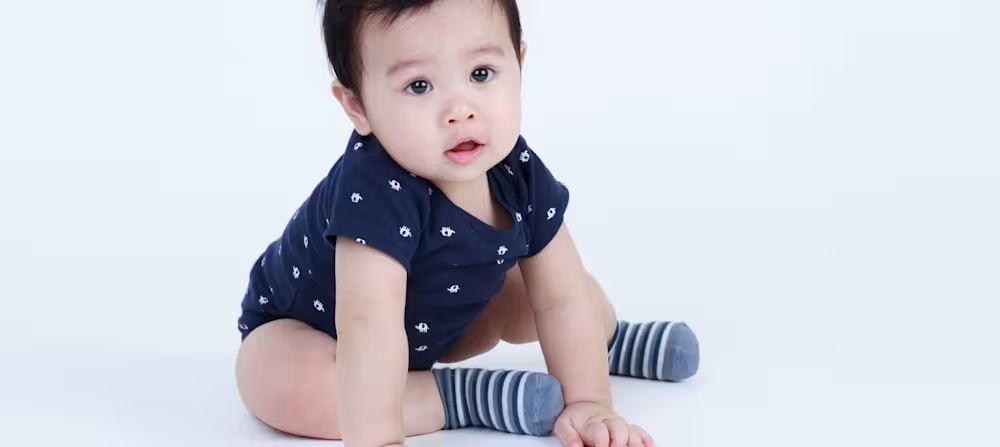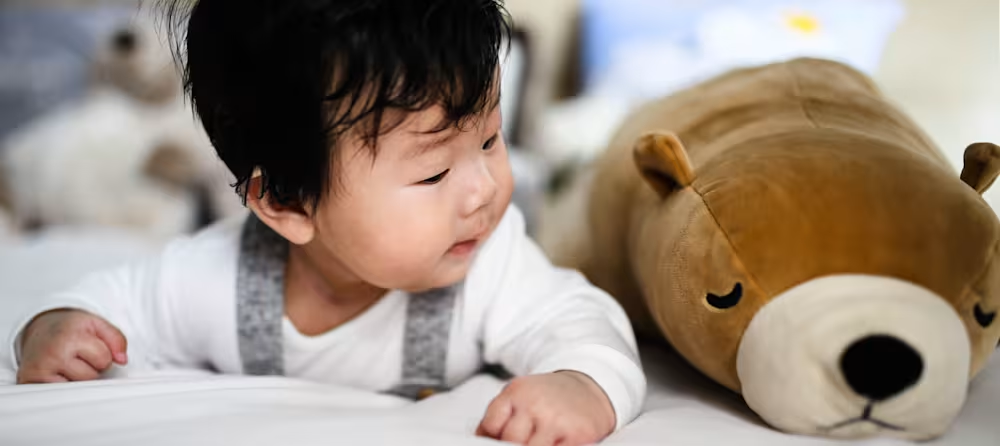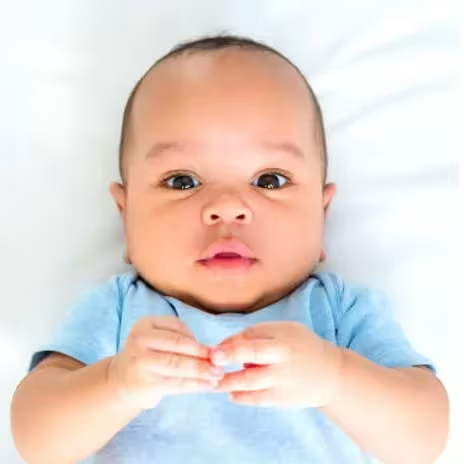How to help a teething baby sleep through the night
Updated Jan 02, 2026
Up-to-date

There’s no doubt about it: the newborn and infant months are tough. Sometimes your baby is going to cry, even when their tummy is full and their diaper is dry. When your infant seems to be incredibly fussy — especially at night — it’s natural to wonder what’s going on. Is that first tooth finally coming in?
We’ll help you figure out whether your baby is teething, and what you can do to help soothe their swollen gums so you can all get more restful sleep.
Signs that your baby is teething
Like many things involving babies, there’s a wide range of normal when it comes to teething. Some babies may barely show signs of discomfort when a tooth's emerging, and others will howl!
While teething symptoms can vary quite a bit, the most common signs include:
Swollen, tender gums
Irritability/fussiness
Increased biting or chewing (e.g. on their hands, toys/books, your nipples — ouch!)
New night waking and/or sleep resistance
Refusal to eat
Slight increase in temperature (under 100.4°F/38°C)*
Increased drooling
*Contrary to popular belief, fever isn’t considered a teething symptom, and could be a sign of underlying illness. If your baby’s temperature reaches 100.4°F (38°C) or higher, or if they have additional symptoms such as vomiting or diarrhea, talk to your pediatrician.
Do babies sleep more when teething?
Although anecdotally, some parents say that their babies have slept more while teething — almost as if they were under the weather and needed more rest — experts say that, for the most part, this isn't the case. Often, the opposite is true: Most parents find that their teething baby won't sleep.
If you've noticed that your baby is sleeping more while teething, it could be related to something else, like a growth spurt.
Teething vs sleep regression
Since increased night waking and nap refusal can also be signs of a , many parents wonder how to tell the difference between the two. Keep in mind that if teething is the primary cause of the new sleep patterns, you’ll likely see other signs of discomfort during waking hours.
Another big hint: discomfort is more likely to cause waking in the midst of a sleep cycle, rather than only waking at the end of one. For example, a 4 month old baby who starts waking frequently due to the may start waking briefly in between their 50-minute sleep cycles. However, a baby who is waking from discomfort (teething or otherwise) may wake after just 10 or 20 minutes of slumber.
Does teething in babies affect sleep?
It can - the American Academy of Pediatrics says that the pain and discomfort from teething can keep babies awake. But wakefulness you might notice during this time could also be related to other things, like developmental sleep regression or a growth spurt. (You can ready about here.)
How long does teething fussiness last?
We won't lie — it may feel like an eternity while you're going through it. But teething fussiness will end, usually sometime between the ages of 2 - 3 years. Keep in mind also that teething pain isn't constant, and there will be periods of time when your child isn't actively cutting new chompers.
When does teething begin?
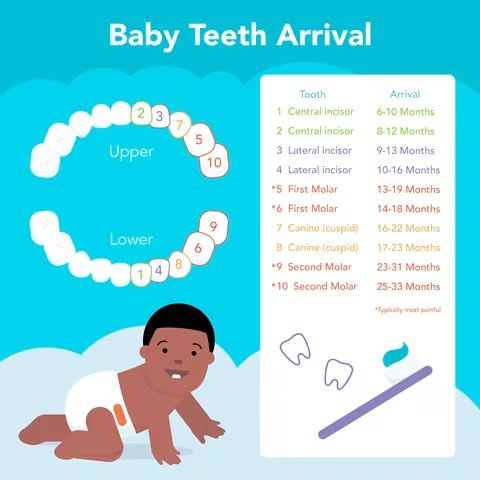
There’s a wide range of normal when it comes to teething. The American Academy of Pediatrics [] says most babies cut their first teeth between 4 - 7 months old. The American Dental Association [] places the range at 6 - 10 months.
There’s no need to worry, though, if your baby’s a bit older and you haven’t seen any teeth yet. According to the American Academy of Pediatric Dentistry [], some babies won’t start teething until a little later — between 12 - 14 months of age.
If your baby doesn’t have teeth by that point, or you have any concerns, it’s a good idea to chat with your pediatric dentist or healthcare provider.
Teething infants
Your baby will likely have one or two teeth erupt at a time, which means you can expect intermittent teething for the first few years. (Yes, we said years. But in general, the first few months are the hardest, and it will get easier for a while — until the molars come in.)
The front teeth on the bottom (the central incisors) are typically the first to appear [], followed by the front teeth on the top.
A study on teething [] found that teething symptoms tend to occur within an 8-day window: the 4 days before a tooth emerges, the day the tooth erupts, and the 3 days after it. Luckily, not all teeth will bring the same level of discomfort when they emerge.
When does teething end?
Most (though not all) children will stop teething, and have all 20 baby teeth, by 3 years of age. Again, all kids are different, but caregivers often report that teething discomfort seems particularly acute when toddlers cut their molars (likely due to the larger surface area).
Teething toddlers
While you can expect those big molars to appear during toddlerhood, on the plus side, older toddlers will often have an easier time communicating with parents. Teething in infancy can leave you guessing, but toddlers are usually able to directly tell you whether their mouth hurts them or not.
Home remedies for teething pain
Are there home remedies that work?
Chewing on cold items can help numb pain and reduce inflammation. If your baby has sore gums, try these AAP-approved remedies:
Use a clean finger to rub/massage swollen gums
Offer a teething toy or teething ring made from firm rubber/silicone to gnaw on
Chill a wet, twisted washcloth in the freezer for 30 minutes for baby to chew
Older babies who have been introduced to solids may enjoy chomping on a frozen banana or bagel — just be sure to monitor this closely in case a piece breaks off.
Chat with your pediatrician before giving acetaminophen (Tylenol/Paracetamol).
What should you avoid?
The AAP cautions against using the following home remedies:
Medications and pain relievers that are applied directly to gums (most will wash out of baby’s mouth too quickly, and others may be harmful)
Teething tablets that contain belladonna and gels with benzocaine
Teething necklaces and beads, which are strangulation and choking hazards
Plastic teethers with a liquid center
4 tips to soothe a teething baby at night
While some lost sleep may be inevitable during temporary periods of discomfort, these tips can help your teething baby get through the night with minimal disruptions.
Tip | What to do | Why it helps |
|---|---|---|
Massage gums before feeding | Gently rub swollen gums with a clean finger dipped in cool water before bedtime feeds | Eases pain so babies can eat more fully and are less likely to wake from hunger |
Prep soothers (and consider medication) | Chill washcloths, gather teething toys, and consider age-appropriate pain relief with doctor guidance | Reduces discomfort during night wakings and supports longer stretches of sleep |
Move bedtime earlier after short naps | Start bedtime 15 - 30 minutes earlier if naps were disrupted | Prevents overtiredness, which can worsen night wakings |
Offer comfort, keep the routine | Give extra cuddles while sticking to your usual bedtime routine | Provides reassurance without creating new sleep associations |
Find more information below:
1. Plan a pre-feeding massage
Teething discomfort can make it challenging for your baby to breast or bottle feed, which can lead to additional night wakings due to hunger.
How to break this cycle? If your baby’s teething, set aside a few extra minutes before your pre-bedtime feeding to apply some pressure to swollen gums. Dip your clean finger in cool water and gently massage the area where the tooth is erupting.
This can help reduce pain before eating, which can lead to a fuller feeding and lessen the chances that your baby will wake early from hunger.
2. Prep the soothers and consider medicine
If a new tooth has been making your baby fussy all day, it’s a good idea to prepare ahead of time for additional night wakings. Stick a stash of wet washcloths in the freezer before bed, and gather your teething toys close by. You might even pop a silicone ring in the crib next to your baby, after they fall asleep if they have the motor skills to grab it during the night.
For babies who are in obvious discomfort, consider offering a pain reliever before bedtime to help them sleep easier. (As always, speak to your medical provider first.)

3. Move bedtime earlier if naps have been short
Since teething discomfort can interfere with your baby’s normal daytime routine, you might find that naps are short — or even skipped entirely. This, in turn, can lead to overtiredness by bedtime, which can increase sleep challenges at night.
If your baby’s had a rough nap day, go ahead and start your bedtime routine 15 - 30 minutes earlier than normal. It seems counterintuitive, but overtiredness can make it more difficult for babies to fall asleep and stay asleep, so you’ll definitely want to avoid it when possible.
4. Offer additional comfort, but stick to your routine
When your baby’s having a tough time teething, they may be extra fussy or clingy — especially at sleep times. Go ahead and offer extra snuggles to help comfort your baby.
However, do try to stick to your regular bedtime routine as much as possible. Veering away from normal sleep patterns — e.g., by offering lots of extra assistance falling asleep — can lead to the development of new sleep onset associations. These can disrupt sleep [] even once the teething is over.
Takeaway
Common signs of teething in children can include increased fussiness, swollen and tender gums, increased biting and chewing (on hands, books, etc.), refusal to eat, new night waking, slight increase in temperature (under 100.4°F/38°C), and increased drooling.
There's a wide range of normal when it comes to when your baby's teeth will come in. Some babies get teeth as early as 4 - 7 months while others may start teething later, around 12 - 14 months. Children usually have their 20 baby teeth by 3 years of age. However, most of the time the first few months of teething are the hardest then it gets easier for your little one until pesky molars erupt, typically in toddlerhood.
You can massage your little one's sore gums to offer relief. Other home remedies include letting your baby chew on a teething toy or twisted cold washcloth. If your child is older and eating solids, offering frozen banana or bagel to chomp on may help (with adult supervision in case a piece falls off).
To help your child sleep better while teething, try things like a pre-feeding massage, giving a pain reliever like Tylenol before bedtime (always check with your child's doctor first), moving bedtime earlier if naps have been short during the day, and offering additional comfort while sticking to regular bedtime routines. Veering too far away from your normal sleep routines may lead to new sleep onset associations that can ultimately disrupt sleep once teething is over.
Teething nighttime fussiness FAQ
Share article:
Note: The content on this site is for informational purposes only and should not replace medical advice from your doctor, pediatrician, or medical professional. If you have questions or concerns, you should contact a medical professional.


